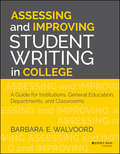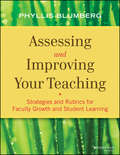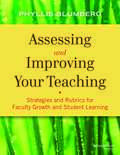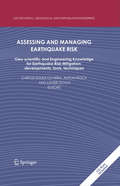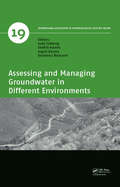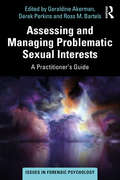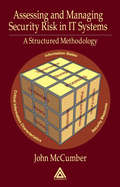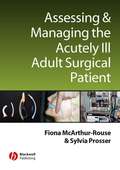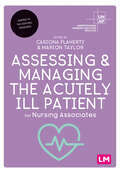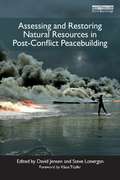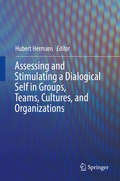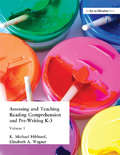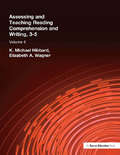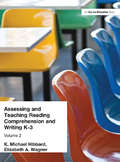- Table View
- List View
Assessing and Improving Student Writing in College: A Guide for Institutions, General Education, Departments, and Classrooms
by Barbara E. WalvoordStep-by-step guidance for shaping better writers while keeping faculty workloads manageable Effective communication is a critical skill for many academic disciplines and careers, and so colleges and universities and their faculty members are rightfully committed to improving student writing across the curriculum. Guiding and assessing student writing in classrooms, general education, and departments takes knowledge, planning, and persistence, but it can be done effectively and efficiently. Written in the concise, accessible style Barbara Walvoord is known for, Assessing and Improving Student Writing in College: A Guide for Institutions, General Education, Departments, and Classrooms offers administrators, program chairs, general education leaders, and classroom instructors the guidance they need. The book provides concrete suggestions for how to: Articulate goals for student writing Measure student writing Improve student writing Document that improvement The book begins by addressing four basic concepts: what we mean by writing, what we mean by "good" writing, how students learn to write, and the purposes of assessment. Next, Walvoord explains the various approaches and methods for assessing writing, urging a combination of them adapted to the institution's purposes and political context. After this introduction, successive chapters offer realistic, practical advice to institution-wide and general education leaders, department members, and classroom instructors. Walvoord addresses issues such as how to engage faculty, how to use rubrics, how to aggregate assessment information at the department and institutional levels, and how to report assessment information to accreditors. The chapter for classroom instructors offers practical suggestions: how to add more writing to a course without substantially increasing the grading load; how to construct writing assignments, how to make grading and responding more effective and time-efficient, how to address grammar and punctuation, and how to support students whose native language is not English. The book also includes four helpful appendices: a taxonomy of Writing Across the Curriculum (WAC) and Writing in the Disciplines (WID) programs; sample outlines for faculty development workshops; a student survey on teaching methods instructors can use to inform their choices in the classroom; and a student self-check cover sheet designed to help students take ownership of their own learning and responsibility for turning in complete, correct assignments. Practical, step-by-step guidance for each point in the assessment and improvement process creates a cohesive, institution-wide system that keeps students, faculty, and administrators on the same page.
Assessing and Improving Student Writing in College: A Guide for Institutions, General Education, Departments, and Classrooms
by Barbara E. WalvoordStep-by-step guidance for shaping better writers while keeping faculty workloads manageable Effective communication is a critical skill for many academic disciplines and careers, and so colleges and universities and their faculty members are rightfully committed to improving student writing across the curriculum. Guiding and assessing student writing in classrooms, general education, and departments takes knowledge, planning, and persistence, but it can be done effectively and efficiently. Written in the concise, accessible style Barbara Walvoord is known for, Assessing and Improving Student Writing in College: A Guide for Institutions, General Education, Departments, and Classrooms offers administrators, program chairs, general education leaders, and classroom instructors the guidance they need. The book provides concrete suggestions for how to: Articulate goals for student writing Measure student writing Improve student writing Document that improvement The book begins by addressing four basic concepts: what we mean by writing, what we mean by "good" writing, how students learn to write, and the purposes of assessment. Next, Walvoord explains the various approaches and methods for assessing writing, urging a combination of them adapted to the institution's purposes and political context. After this introduction, successive chapters offer realistic, practical advice to institution-wide and general education leaders, department members, and classroom instructors. Walvoord addresses issues such as how to engage faculty, how to use rubrics, how to aggregate assessment information at the department and institutional levels, and how to report assessment information to accreditors. The chapter for classroom instructors offers practical suggestions: how to add more writing to a course without substantially increasing the grading load; how to construct writing assignments, how to make grading and responding more effective and time-efficient, how to address grammar and punctuation, and how to support students whose native language is not English. The book also includes four helpful appendices: a taxonomy of Writing Across the Curriculum (WAC) and Writing in the Disciplines (WID) programs; sample outlines for faculty development workshops; a student survey on teaching methods instructors can use to inform their choices in the classroom; and a student self-check cover sheet designed to help students take ownership of their own learning and responsibility for turning in complete, correct assignments. Practical, step-by-step guidance for each point in the assessment and improvement process creates a cohesive, institution-wide system that keeps students, faculty, and administrators on the same page.
Assessing and Improving Your Teaching: Strategies and Rubrics for Faculty Growth and Student Learning
by Phyllis BlumbergIn order to make appropriate changes to improve your teaching and your students’ learning, first you need to know how you’re teaching now. Figure it out for yourself and invigorate your teaching on your own terms! This practical evidence-based guide promotes excellence in teaching and improved student learning through self-reflection and self-assessment of one’s teaching. Phyllis Blumberg starts by reviewing the current approaches to instructor evaluation and describes their inadequacies. She then presents a new model of assessing teaching that builds upon a broader base of evidence and sources of support. This new model leads to self-assessment rubrics, which are available for download, and the book will guide you in how to use them. The book includes case studies of completed critical reflection rubrics from a variety of disciplines, including the performing and visual arts and the hard sciences, to show how they can be used in different ways and how to explore the richness of the data you’ll uncover.
Assessing and Improving Your Teaching: Strategies and Rubrics for Faculty Growth and Student Learning
by Phyllis BlumbergIn order to make appropriate changes to improve your teaching and your students’ learning, first you need to know how you’re teaching now. Figure it out for yourself and invigorate your teaching on your own terms! This practical evidence-based guide promotes excellence in teaching and improved student learning through self-reflection and self-assessment of one’s teaching. Phyllis Blumberg starts by reviewing the current approaches to instructor evaluation and describes their inadequacies. She then presents a new model of assessing teaching that builds upon a broader base of evidence and sources of support. This new model leads to self-assessment rubrics, which are available for download, and the book will guide you in how to use them. The book includes case studies of completed critical reflection rubrics from a variety of disciplines, including the performing and visual arts and the hard sciences, to show how they can be used in different ways and how to explore the richness of the data you’ll uncover.
Assessing and Insuring Cybersecurity Risk
by Ravi DasRemote workforces using VPNs, cloud-based infrastructure and critical systems, and a proliferation in phishing attacks and fraudulent websites are all raising the level of risk for every company. It all comes down to just one thing that is at stake: how to gauge a company’s level of cyber risk and the tolerance level for this risk. Loosely put, this translates to how much uncertainty an organization can tolerate before it starts to negatively affect mission critical flows and business processes. Trying to gauge this can be a huge and nebulous task for any IT security team to accomplish. Making this task so difficult are the many frameworks and models that can be utilized. It is very confusing to know which one to utilize in order to achieve a high level of security. Complicating this situation further is that both quantitative and qualitative variables must be considered and deployed into a cyber risk model. Assessing and Insuring Cybersecurity Risk provides an insight into how to gauge an organization’s particular level of cyber risk, and what would be deemed appropriate for the organization’s risk tolerance. In addition to computing the level of cyber risk, an IT security team has to determine the appropriate controls that are needed to mitigate cyber risk. Also to be considered are the standards and best practices that the IT security team has to implement for complying with such regulations and mandates as CCPA, GDPR, and the HIPAA. To help a security team to comprehensively assess an organization’s cyber risk level and how to insure against it, the book covers: The mechanics of cyber risk Risk controls that need to be put into place The issues and benefits of cybersecurity risk insurance policies GDPR, CCPA, and the the CMMC Gauging how much cyber risk and uncertainty an organization can tolerate is a complex and complicated task, and this book helps to make it more understandable and manageable.
Assessing and Insuring Cybersecurity Risk
by Ravi DasRemote workforces using VPNs, cloud-based infrastructure and critical systems, and a proliferation in phishing attacks and fraudulent websites are all raising the level of risk for every company. It all comes down to just one thing that is at stake: how to gauge a company’s level of cyber risk and the tolerance level for this risk. Loosely put, this translates to how much uncertainty an organization can tolerate before it starts to negatively affect mission critical flows and business processes. Trying to gauge this can be a huge and nebulous task for any IT security team to accomplish. Making this task so difficult are the many frameworks and models that can be utilized. It is very confusing to know which one to utilize in order to achieve a high level of security. Complicating this situation further is that both quantitative and qualitative variables must be considered and deployed into a cyber risk model. Assessing and Insuring Cybersecurity Risk provides an insight into how to gauge an organization’s particular level of cyber risk, and what would be deemed appropriate for the organization’s risk tolerance. In addition to computing the level of cyber risk, an IT security team has to determine the appropriate controls that are needed to mitigate cyber risk. Also to be considered are the standards and best practices that the IT security team has to implement for complying with such regulations and mandates as CCPA, GDPR, and the HIPAA. To help a security team to comprehensively assess an organization’s cyber risk level and how to insure against it, the book covers: The mechanics of cyber risk Risk controls that need to be put into place The issues and benefits of cybersecurity risk insurance policies GDPR, CCPA, and the the CMMC Gauging how much cyber risk and uncertainty an organization can tolerate is a complex and complicated task, and this book helps to make it more understandable and manageable.
Assessing and Managing Earthquake Risk: Geo-scientific and Engineering Knowledge for Earthquake Risk Mitigation: developments, tools, techniques (Geotechnical, Geological and Earthquake Engineering #2)
by Carlos Sousa Oliveira Antoni Roca Xavier Goula* Multidisciplinary approach of risk assessment and management, which can provide more efficient earthquake mitigation.* Transfer of Geo-scientific and engineering knowledge to Civil Protection and insurance agents* Approaches and common practices directly related to the preparation of earthquake emergency plans* Illustrated examples of actual applications, including web sites * Case-studies and information on relevant international projects
Assessing and Managing Groundwater in Different Environments (IAH - Selected Papers on Hydrogeology)
by Jude Cobbing Shafick Adams Ingrid Dennis Kornelius RiemannThis collection of papers is a snapshot of modern hydrogeology in which highly technical methods and approaches sit side-by-side with overlapping legal, social, organisational, institutional and governance considerations. Groundwater is integral to many human and environmental systems. Indeed, there appears to be a growing realisation that some of the most pressing physical problems in the field of hydrogeology - over-abstraction, salinization or pollution - can only really be solved by taking a multi-disciplinary approach to the issues that takes all other related professions into account. Whilst a ‘technical’ solution may be readily deciphered, the larger challenge usually lies in the sustainably-funded and widely-accepted implementation of that measure. This book ranges from discussion and debate on the hot topic of hydraulic fracturing of wells or ‘fraccing’ for shale gas and its potential to disrupt groundwater systems, to the application of highly technical modelling procedures to help solve complex, real world problems. It is a window on the preoccupations of modern hydrogeologists and an insight into the way in which hydrogeological techniques and methods are being holistically adapted to address problems in the real world. This book is targeted at professional hydrogeologists, sociologists, experts in governance, law and policy as well as ecologists and other professionals that nowadays all sit alongside groundwater understanding. The book will also appeal to politicians, resource managers, regulators and others interested in sustainable water supply.
Assessing and Managing Problematic Sexual Interests: A Practitioner's Guide
by Geraldine AkermanAssessing and Managing Problematic Sexual Interests: A Practitioner’s Guide provides a thorough review of atypical sexual interests and offers various ways through which they can be measured and controlled, including compassion-focused and psychoanalytic approaches. This unique guide presents a detailed analysis of deviant sexual interest. Part I, 'Assessment,' overviews the range of sexual interests and fantasies in men and women. Part II, 'Management,' investigates the cutting-edge tools, approaches, interventions, and treatment advances used in a variety of settings to control deviant sexual interest. In Part III, 'Approaches to assessment and management', the authors consider how females with sexual convictions can be assessed and how offence paralelling behaviour can be used for assessment and treatment. Throughout, Assessing and Managing Problematic Sexual Interests offers necessary perspectives and emerging research from international experts at the forefront of this field. With a thorough assessment of current research and a critical overview of treatment advances for problematic sexual interests, Assessing and Managing Problematic Sexual Interests is an essential resource for clinical and forensic psychologists, probation officers, academics, students working in the field, and members of allied professional fields.
Assessing and Managing Problematic Sexual Interests: A Practitioner's Guide
by Geraldine Akerman Derek Perkins Ross BartelsAssessing and Managing Problematic Sexual Interests: A Practitioner’s Guide provides a thorough review of atypical sexual interests and offers various ways through which they can be measured and controlled, including compassion-focused and psychoanalytic approaches. This unique guide presents a detailed analysis of deviant sexual interest. Part I, 'Assessment,' overviews the range of sexual interests and fantasies in men and women. Part II, 'Management,' investigates the cutting-edge tools, approaches, interventions, and treatment advances used in a variety of settings to control deviant sexual interest. In Part III, 'Approaches to assessment and management', the authors consider how females with sexual convictions can be assessed and how offence paralelling behaviour can be used for assessment and treatment. Throughout, Assessing and Managing Problematic Sexual Interests offers necessary perspectives and emerging research from international experts at the forefront of this field. With a thorough assessment of current research and a critical overview of treatment advances for problematic sexual interests, Assessing and Managing Problematic Sexual Interests is an essential resource for clinical and forensic psychologists, probation officers, academics, students working in the field, and members of allied professional fields.
Assessing and Managing Security Risk in IT Systems: A Structured Methodology
by John McCumberThis book begins with an overview of information systems security, offering the basic underpinnings of information security and concluding with an analysis of risk management. Part II describes the McCumber Cube, providing the original paper from 1991 and detailing ways to accurately map information flow in computer and telecom systems. It also explains how to apply the methodology to individual system components and subsystems. Part III serves as a resource for analysts and security practitioners who want access to more detailed information on technical vulnerabilities and risk assessment analytics. McCumber details how information extracted from this resource can be applied to his assessment processes.
Assessing and Managing Security Risk in IT Systems: A Structured Methodology
by John McCumberThis book begins with an overview of information systems security, offering the basic underpinnings of information security and concluding with an analysis of risk management. Part II describes the McCumber Cube, providing the original paper from 1991 and detailing ways to accurately map information flow in computer and telecom systems. It also explains how to apply the methodology to individual system components and subsystems. Part III serves as a resource for analysts and security practitioners who want access to more detailed information on technical vulnerabilities and risk assessment analytics. McCumber details how information extracted from this resource can be applied to his assessment processes.
Assessing and Managing the Acutely Ill Adult Surgical Patient
by Fiona McArthur-Rouse Sylvia ProsserAssessing and managing the acutely ill adult surgical patient focuses on major surgical conditions and interventions commonly encountered in District General Hospitals which potentially require intensive monitoring and intervention. It emphasizes the importance of thorough assessment and interpretation of clinical data, and provides the necessary knowledge to help nurses make sense of their findings and to integrate theory and practice in relation to surgical care. Part one addresses principles of surgical care for all patients undergoing surgery — including pre-operative assessment and preparation, the peri-operative period and post-operative recovery, post-operative pain management and psychosocial aspects of surgery — which underpin the knowledge and rationale for practice. Part two considers specific surgical conditions and interventions, organised according to surgical specialities. Each chapter considers the underlying patho-physiology, investigation and diagnosis, assessment, monitoring and management of common acute surgical conditions within that specialty.
Assessing and Managing the Acutely Ill Patient for Nursing Associates (Understanding Nursing Associate Practice)
by Marion Taylor Cariona FlahertyAcutely ill adults present in a variety of settings and caring for them is a key part of the nursing associate role. This book equips you with the skills and knowledge to assess the acutely ill adult and manage their care. Each chapter follows a case study of a patient presenting with an acute illness, working step-by-step through their assessment and care whilst drawing on relevant pathophysiology, pharmacology and evidence-based practice. Written in clear language specifically for the nursing associate, this is your perfect introduction to the world of acute care. Key features Fully mapped to the NMC Standards of Proficiency for Nursing Associates (2018) Introduces a range of commonly encountered acute illnesses across different body systems A unique case study approach uses real-world practice scenarios to make understanding the complex theory, pathophysiology and pharmacology much easier Focuses specifically on the requirements of the nursing associate role, helping you to develop into a confident professional practitioner
Assessing and Managing the Acutely Ill Patient for Nursing Associates (Understanding Nursing Associate Practice)
by Marion Taylor Cariona FlahertyAcutely ill adults present in a variety of settings and caring for them is a key part of the nursing associate role. This book equips you with the skills and knowledge to assess the acutely ill adult and manage their care. Each chapter follows a case study of a patient presenting with an acute illness, working step-by-step through their assessment and care whilst drawing on relevant pathophysiology, pharmacology and evidence-based practice. Written in clear language specifically for the nursing associate, this is your perfect introduction to the world of acute care. Key features Fully mapped to the NMC Standards of Proficiency for Nursing Associates (2018) Introduces a range of commonly encountered acute illnesses across different body systems A unique case study approach uses real-world practice scenarios to make understanding the complex theory, pathophysiology and pharmacology much easier Focuses specifically on the requirements of the nursing associate role, helping you to develop into a confident professional practitioner
Assessing and Managing the Acutely Ill Patient for Nursing Associates (Understanding Nursing Associate Practice)
Acutely ill adults present in a variety of settings and caring for them is a key part of the nursing associate role. This book equips you with the skills and knowledge to assess the acutely ill adult and manage their care. Each chapter follows a case study of a patient presenting with an acute illness, working step-by-step through their assessment and care whilst drawing on relevant pathophysiology, pharmacology and evidence-based practice. Written in clear language specifically for the nursing associate, this is your perfect introduction to the world of acute care. Key features Fully mapped to the NMC Standards of Proficiency for Nursing Associates (2018) Introduces a range of commonly encountered acute illnesses across different body systems A unique case study approach uses real-world practice scenarios to make understanding the complex theory, pathophysiology and pharmacology much easier Focuses specifically on the requirements of the nursing associate role, helping you to develop into a confident professional practitioner
Assessing and Restoring Natural Resources In Post-Conflict Peacebuilding (Post-Conflict Peacebuilding and Natural Resource Management)
by David Jensen Stephen LonerganWhen a country emerges from violent conflict, the management of the environment and natural resources has important implications for short-term peacebuilding and long-term stability, particularly if natural resources were a factor in the conflict, play a major role in the national economy, or broadly support livelihoods. Only recently, however, have the assessment, harnessing, and restoration of the natural resource base become essential components of postconflict peacebuilding. This book, by thirty-five authors, examines the experiences of more than twenty countries and territories in assessing post-conflict environmental damage and natural resource degradation and their implications for human health, livelihoods, and security. The book also illustrates how an understanding of both the risks and opportunities associated with natural resources can help decision makers manage natural resources in ways that create jobs, sustain livelihoods, and contribute to economic recovery and reconciliation, without creating new grievances or significant environmental degradation. Finally, the book offers lessons from the remediation of environmental hot spots, restoration of damaged ecosystems, and reconstruction of the environmental services and infrastructure necessary for a sustainable peace. Assessing and Restoring Natural Resources in Post-Conflict Peacebuilding is part of a global initiative to identify and analyze lessons in post-conflict peacebuilding and natural resource management. The project has generated six books of case studies and analyses, with contributions by practitioners, policy makers, and researchers. Other books address highvalue resources, land, water, livelihoods, and governance.
Assessing and Restoring Natural Resources In Post-Conflict Peacebuilding: Assessing And Restoring Natural Resources In Post-conflict Peacebuilding (Post-Conflict Peacebuilding and Natural Resource Management)
by David Jensen Steve LonerganWhen a country emerges from violent conflict, the management of the environment and natural resources has important implications for short-term peacebuilding and long-term stability, particularly if natural resources were a factor in the conflict, play a major role in the national economy, or broadly support livelihoods. Only recently, however, have the assessment, harnessing, and restoration of the natural resource base become essential components of postconflict peacebuilding. This book, by thirty-five authors, examines the experiences of more than twenty countries and territories in assessing post-conflict environmental damage and natural resource degradation and their implications for human health, livelihoods, and security. The book also illustrates how an understanding of both the risks and opportunities associated with natural resources can help decision makers manage natural resources in ways that create jobs, sustain livelihoods, and contribute to economic recovery and reconciliation, without creating new grievances or significant environmental degradation. Finally, the book offers lessons from the remediation of environmental hot spots, restoration of damaged ecosystems, and reconstruction of the environmental services and infrastructure necessary for a sustainable peace. Assessing and Restoring Natural Resources in Post-Conflict Peacebuilding is part of a global initiative to identify and analyze lessons in post-conflict peacebuilding and natural resource management. The project has generated six books of case studies and analyses, with contributions by practitioners, policy makers, and researchers. Other books address highvalue resources, land, water, livelihoods, and governance.
Assessing and Stimulating a Dialogical Self in Groups, Teams, Cultures, and Organizations
by Hubert HermansThis book presents 9 theory-based and practice-oriented methods for assessing and stimulating a multi-voiced dialogical self in the context of groups, teams, cultures, and organizations. All of these methods are based on Dialogical Self Theory. The book deals with the practical implications of this theory as applied in the areas of coaching, training, and counselling. A number of chapters focus on the process of positioning and dialogue on the level of the self, while other chapters combine self-processes with group work, and still others find their applications in leadership development and team-work in organizations. For each of the nine methods, the chapters present theory, method, case-study and discussions and make clear what kind of problems can be tackled using the method discussed. Specifically, the book discusses the following methods: A Negotiational Self Method for assessing and solving inner conflicts; a Self-Confrontation Method used to assess and stimulate personal meaning construction in career counselling; a Method of Expressive Writing in the context of career development; a Composition Method for studying the content and organization of personal positions via verbal and non-verbal procedures; a Dialogical Leadership Method that investigates and stimulates dialogical relationships between personal positions in the self of leaders in organizations; a Personal Position Repertoire Method that combines the assessment of personal positions with focus group discussions; a Team Confrontation Method for investigating collective and deviant positions or voices in organizational teams; a Method for Revising Organizational Stories with a focus on their emotional significance: and a Technique for Assessing and Stimulating Innovative Dialogue between Cultural Positions in global nomads.
Assessing and Teaching Reading Composition and Pre-Writing, K-3, Vol. 1
by K. Michael Hibbard Elizabeth WagnerThe performance tasks in this book are linked directly to instructional strategies and include holistic rubrics, analytic rubrics, and assessment lists. They can be photocopied and distributed to your students.
Assessing and Teaching Reading Composition and Pre-Writing, K-3, Vol. 1
by K. Michael Hibbard Elizabeth WagnerThe performance tasks in this book are linked directly to instructional strategies and include holistic rubrics, analytic rubrics, and assessment lists. They can be photocopied and distributed to your students.
Assessing and Teaching Reading Composition and Writing, 3-5, Vol. 4
by K. Michael Hibbard Elizabeth WagnerThe performance tasks in this book are linked directly to instructional strategies and include holistic rubrics, analytic rubrics, and assessment lists. They can be photocopied and distributed to your students. Included in this series are 98 performance tasks, 196 assessment lists, 18 holistic rubrics, 30 analytic rubrics, and 88 graphic organizers.
Assessing and Teaching Reading Composition and Writing, 3-5, Vol. 4
by K. Michael Hibbard Elizabeth WagnerThe performance tasks in this book are linked directly to instructional strategies and include holistic rubrics, analytic rubrics, and assessment lists. They can be photocopied and distributed to your students. Included in this series are 98 performance tasks, 196 assessment lists, 18 holistic rubrics, 30 analytic rubrics, and 88 graphic organizers.
Assessing and Teaching Reading Composition and Writing, K-3, Vol. 2
by K. Michael Hibbard Elizabeth WagnerThe performance tasks in this book are linked directly to instructional strategies and include holistic rubrics, analytic rubrics, and assessment lists. They can be photocopied and distributed to your students.
Assessing and Teaching Reading Composition and Writing, K-3, Vol. 2
by K. Michael Hibbard Elizabeth WagnerThe performance tasks in this book are linked directly to instructional strategies and include holistic rubrics, analytic rubrics, and assessment lists. They can be photocopied and distributed to your students.
